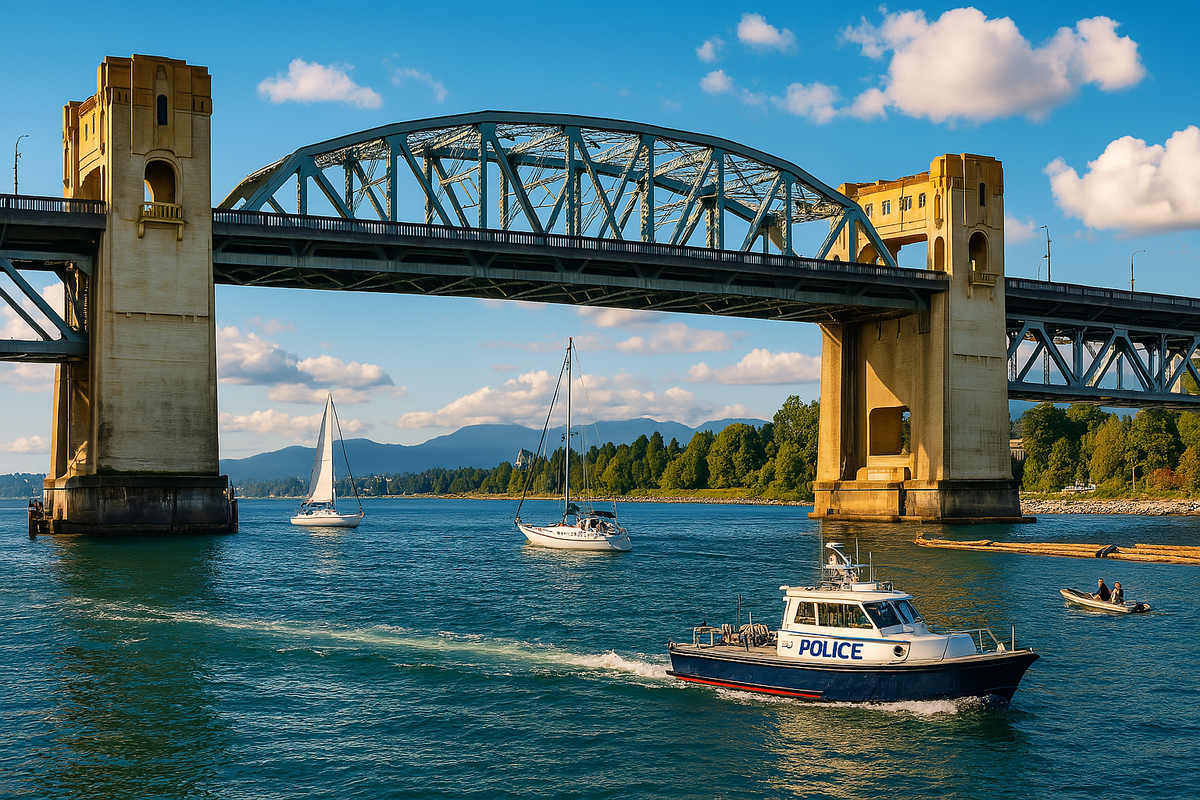
Vancouver, BC - March 30, 2025 - The Burrard Street Bridge, an iconic landmark in Vancouver, spans English Bay, connecting downtown to Kitsilano. Built in 1932, this Art Deco-style bridge was designed by architect John R. Grant and engineer Colonel Charles A. Tate. Over the years, it has been a key transportation route, supporting cars, bicycles, and pedestrians. But beneath its grand arches, a fascinating world of marine life, infrastructure, and human activity unfolds daily.
The Construction and Evolution of the Burrard Street Bridge
The Burrard Street Bridge was a major feat of engineering when it was completed during the Great Depression. Using reinforced concrete and steel, it was built to support growing traffic demands. The bridge features a steel truss cantilever design, and its total length is about 700 meters (2,300 feet). It stands approximately 30 meters (98 feet) above False Creek, allowing for the passage of ships and other marine traffic. The two huge lamps at both ends of the span—bridge engineer John Grant’s inspiration— are a tribute to Canadian WWI prisoners of war, who huddled around open fires in their prison camps. The lamps are 1965 replacements of the originals, which had to be taken down in 1963 because of corrosion.
The bridge underwent significant renovations in 2016 to improve safety, adding dedicated bike lanes and wider pedestrian paths. While its original Art Deco style remains, modern updates ensure its continued function as a vital crossing. The city of Vancouver also installed suicide prevention fencing on Burrard Bridge in 2016. The barrier’s picket-fence style with strong vertical detail and heritage -style pedestrian lamp posts was designed in collaboration with the Heritage Commission, Heritage Foundation, Heritage Society, Active Transportation Policy Council, Urban Design Panel, Vancouver Coastal Health, B.C. Crisis Centre, the Vancouver Police Department and representatives from the film and television sector.
Infrastructure Below the Bridge
Beneath the bridge lies an intricate network of cables and pipes that support Vancouver’s communication and utility needs. Fiber-optic cables, electrical lines, and water pipes run along its underbelly, hidden from public view but essential to the city’s infrastructure.
Marine Life Under the Bridge
Over the decades, English Bay’s marine life has shifted due to urbanization and climate change. Historically, salmon and herring were abundant, but their numbers have declined. However, seals, sea lions, and even the occasional orca can still be spotted in these waters. If you visit the Vancouver Aquarium in Stanley Park, you can explore an exhibit showcasing local flora and fauna, including giant Pacific octopuses, sea stars, and other marine species that inhabit these waters.
Activities Under the Burrard Street Bridge
The waters beneath the bridge bustle with activity. Pleasure boats, paddleboarders, and kayakers enjoy the scenic route, while Coast Guard vessels and fishing boats navigate its depths. The bridge also sees occasional log booms from the forestry industry being transported through False Creek.
Future Plans and Conservation Efforts
As Vancouver continues to grow, discussions about further bridge upgrades include seismic retrofitting and expanded transit options. Efforts to restore marine habitats are also underway, ensuring that English Bay remains a vibrant ecosystem for years to come.
From its engineering marvels to the lively waters beneath, the Burrard Street Bridge remains a defining part of Vancouver’s landscape, bridging the past and future in more ways than one.
#Burrard Street Bridge #English Bay Vancouver #Vancouver Landmarks #Coastal Wildlife #Vancouver History #Marine Life #Vancouver Tourism #Bridge Views #WBN News Vancouver #Elke Porter
Connect with Elke at Westcoast German Media or on LinkedIn: Elke Porter or contact her on WhatsApp: +1 604 828 8788

